Barista’s Canvas: Exploring the Art of Coffee Shop Architecture in the Golden Era of Cafés
Architizer's 13th A+Awards features a suite of sustainability-focused categories recognizing designers that are building a greener industry — and a better future. Start your entry to receive global recognition for your work!
From a design perspective, one could say that the past decade was all about the bars — with the rise of the speakeasy came a heightened interest in bar interiors. Now, one can argue that we’ve entered the golden age of the coffee shop. From the smell of freshly ground beans to the slow pour of black coffee and the amazing latte art found in every cup, coffee shops have become a new place of gathering.
Apart from social spaces, cafes act as workstations for remote workers or digital nomads, cozy “lounge rooms” for reading books and listening to podcasts and even event spaces that host pouring workshops or book club assemblies. Coffee shops straddle the intersection of public and private space, challenging architects to compose flexible designs and explore the qualities that make a successful cafe.
Slabtitude
By Vaslab Architecture, Bangkok, Thailand
Popular Choice Winner, Restaurants (S < 1000 sq ft), 12th Annual A+Awards

 The ‘slabtitude’ concept is translated into a place for gathering made of exposed concrete surfaces and accompanied by a long wooden table as the key centerpiece. The offices’ storage space was transformed into a café for casual meetings, work sessions and social connections. A series of custom made furniture complement the design, providing different moments of interaction as well as privacy throughout the space.
The ‘slabtitude’ concept is translated into a place for gathering made of exposed concrete surfaces and accompanied by a long wooden table as the key centerpiece. The offices’ storage space was transformed into a café for casual meetings, work sessions and social connections. A series of custom made furniture complement the design, providing different moments of interaction as well as privacy throughout the space.
FSW Coffee
By Phoebe Says Wow Architects Ltd. / PSW???????, Taipei City, Taiwan

 The project is located in a former office space at the corner ground floor of a mixed-use building close to nearby trails from the CBD area of Taipei. Contrary to most coffee shops, this proposal turned the space into a high quality espresso bar with an on-site roasters and space event, carefully concealing the interior from the bustling cityscape. The shop is divided into a semi-open street pocket space, inviting customers to enjoy a quick sip, and a sideways sit-and-drink area for a more casual experience. Polycarbonate panels act as dividers that offer an incredible illuminating effect throughout the day.
The project is located in a former office space at the corner ground floor of a mixed-use building close to nearby trails from the CBD area of Taipei. Contrary to most coffee shops, this proposal turned the space into a high quality espresso bar with an on-site roasters and space event, carefully concealing the interior from the bustling cityscape. The shop is divided into a semi-open street pocket space, inviting customers to enjoy a quick sip, and a sideways sit-and-drink area for a more casual experience. Polycarbonate panels act as dividers that offer an incredible illuminating effect throughout the day.
NANA Coffee Roasters Bangna
By TROP : terrains + open space, Bangkok, Thailand

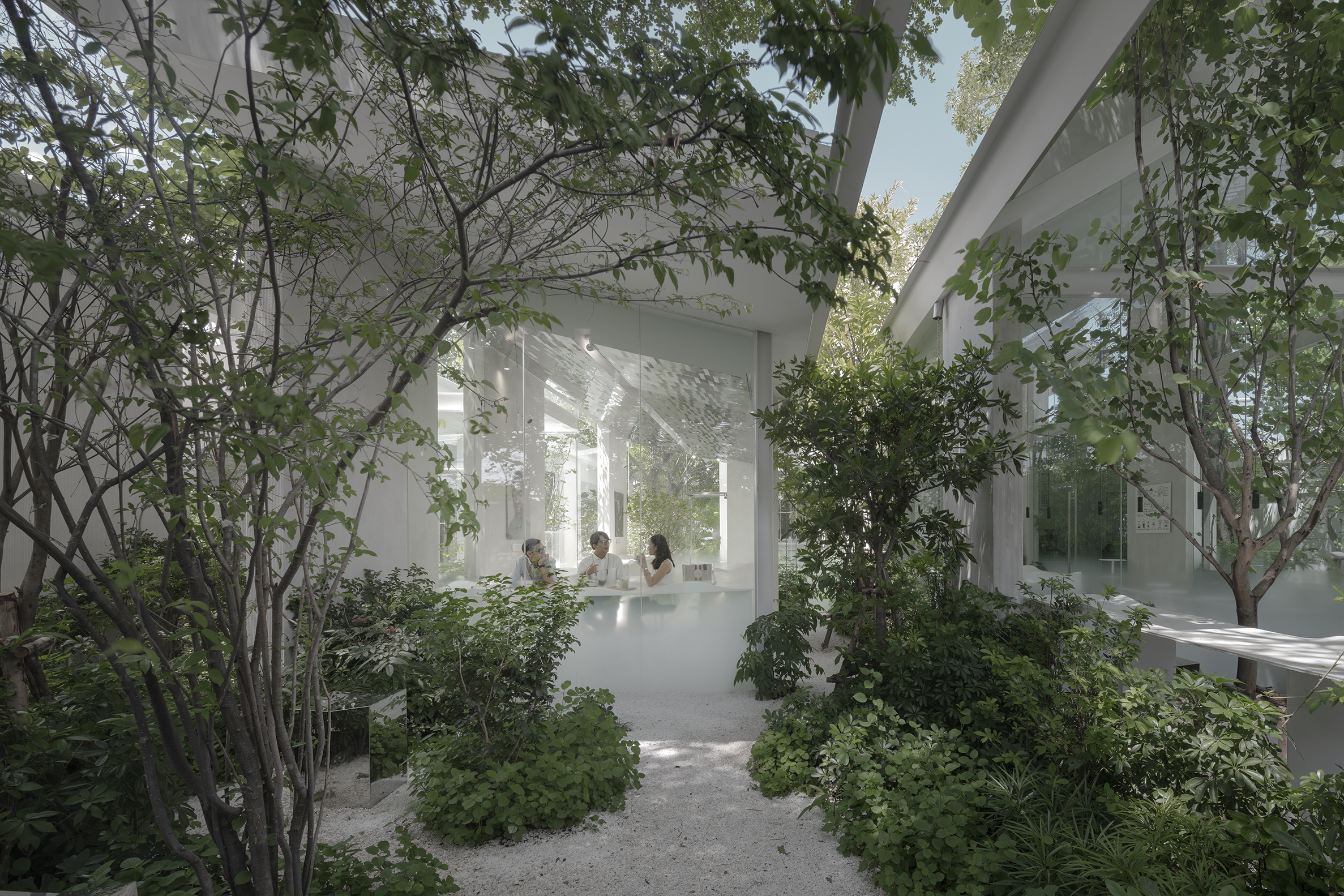 Nana Coffee Roasters Bangna investigates how eco-conscious design can inform a new café proposal along the Bangna-Trad motorway. Through the use of man-made structures and natural resources, the project blurs the boundaries between interior design, landscaping, and architecture and uses the three existing “structures” on site (the house; the road; and the parking) as a starting point for the design. The café layout is comprised of a Slow Bar, a service zone as well as a Speed Bar and indoor seating zone. Finally, lush plant species act as sound buffers and construct peaceful green pockets around the structure.
Nana Coffee Roasters Bangna investigates how eco-conscious design can inform a new café proposal along the Bangna-Trad motorway. Through the use of man-made structures and natural resources, the project blurs the boundaries between interior design, landscaping, and architecture and uses the three existing “structures” on site (the house; the road; and the parking) as a starting point for the design. The café layout is comprised of a Slow Bar, a service zone as well as a Speed Bar and indoor seating zone. Finally, lush plant species act as sound buffers and construct peaceful green pockets around the structure.
The Caffè by Mr Espresso
By jones | haydu, Oakland, California

The Caffè reflects the second generation of Bay Area icon Mr. Espresso, serving as an example of how a diverse cultural landscape operates within a dense urban fabric. Heavily inspired by Italian culture and the ritual of a “pausa” or a pause, the design features elements of minimalism and contrast. The central bar sits as an island within the space, accentuated by an overhead wooden sculpture made of 272 slats of birch plywood.
Blue Bottle Los Gatos
By Lincoln Lighthill Architect, California

 The design for this cafe focused on the idea of how people move through confined spaces and the architectural language that can be derived from these conditions. Using the concept of super quadrics – math equations that yield rounded forms – the café was designed free of sharp corners, ensuring a smooth flow throughout the space. Respectively, the material palette echoes this smoothness, where key furniture pieces such the bar are made of a single solid piece of acrylic polymer (Corian) to reinforce its seamless, continuous form.
The design for this cafe focused on the idea of how people move through confined spaces and the architectural language that can be derived from these conditions. Using the concept of super quadrics – math equations that yield rounded forms – the café was designed free of sharp corners, ensuring a smooth flow throughout the space. Respectively, the material palette echoes this smoothness, where key furniture pieces such the bar are made of a single solid piece of acrylic polymer (Corian) to reinforce its seamless, continuous form.
% Arabica West Jianguo Road
By B.L.U.E. Architecture Studio, Shanghai, China
Popular Winner, Restaurants, 8th Annual A+Awards

 The coffee shop’s design focused on both its façade and interior renovation, creating an interplay between interior and exterior space. The shop becomes completely open through a small courtyard that expands around a U-shaped glass box. The transparent design allows part of the commercial space to blend with the wider urban context, while incorporating, in turn, the surrounding scenery into the store through the integration of parasol trees around the façade.
The coffee shop’s design focused on both its façade and interior renovation, creating an interplay between interior and exterior space. The shop becomes completely open through a small courtyard that expands around a U-shaped glass box. The transparent design allows part of the commercial space to blend with the wider urban context, while incorporating, in turn, the surrounding scenery into the store through the integration of parasol trees around the façade.
Option Coffee Bar
By TOUCH Architect, Udon Thani, Thailand
Popular Choice Winner, Bars & Nightclubs, 8th Annual A+Awards

 Option Coffee Bar hosts three primary functions within the space: a café, a restaurant and a bar and occasionally an event space. The design objective was to create interchangeable zones, where these contrasting functions can occur both separately and simultaneously. Careful attention is given to the façade, which is comprised of a double layer of clear polycarbonate, which creates variation of light throughout the day as well as acts as a sign for the café.
Option Coffee Bar hosts three primary functions within the space: a café, a restaurant and a bar and occasionally an event space. The design objective was to create interchangeable zones, where these contrasting functions can occur both separately and simultaneously. Careful attention is given to the façade, which is comprised of a double layer of clear polycarbonate, which creates variation of light throughout the day as well as acts as a sign for the café.
Architizer's 13th A+Awards features a suite of sustainability-focused categories recognizing designers that are building a greener industry — and a better future. Start your entry to receive global recognition for your work!
Featured Image: FSW Coffee, Taipei City, Taiwan by Phoebe Says Wow Architects Ltd. / PSW???????. Finalist, Bars & Wineries, 10th Annual A+ Awards
The post Barista’s Canvas: Exploring the Art of Coffee Shop Architecture in the Golden Era of Cafés appeared first on Journal.


































 This project suggests a new context for a neglected and isolated urban fabric for the city of St. Louis. The design is comprised of a lightweight architectural canopy that expands outwards across the highway and the abandoned ground, hosting an array of programs. The physical model has been meticulously crafted, showcasing not only the complex geometry of the structure but also the immediate context – fundamental in the project’s inception. Additionally, the physical model vividly conveys the canopy’s fabric materiality, achieving a level of realism and tactile authenticity that digital modeling would struggle to replicate.
This project suggests a new context for a neglected and isolated urban fabric for the city of St. Louis. The design is comprised of a lightweight architectural canopy that expands outwards across the highway and the abandoned ground, hosting an array of programs. The physical model has been meticulously crafted, showcasing not only the complex geometry of the structure but also the immediate context – fundamental in the project’s inception. Additionally, the physical model vividly conveys the canopy’s fabric materiality, achieving a level of realism and tactile authenticity that digital modeling would struggle to replicate. ‘The field is elongated, rural, planted with olive trees. The land is dominant. –How could a residence rise out of the ground; how could it be confined to a roof? The residence is its roof. A sixty meters long one. While approaching the plot, it can be perceived as a slightly elevated strip of earthy crust in front of the distant mountains of Euboea. It can be walked on. The roof is born from and returns back to the ground/’
‘The field is elongated, rural, planted with olive trees. The land is dominant. –How could a residence rise out of the ground; how could it be confined to a roof? The residence is its roof. A sixty meters long one. While approaching the plot, it can be perceived as a slightly elevated strip of earthy crust in front of the distant mountains of Euboea. It can be walked on. The roof is born from and returns back to the ground/’ This 1,640-square-foot-tall tower will anchor a new financial district in Nanjing. Being part (and eventually the winner) of an international design competition, AS+GG put a lot of their effort into creating a physical model that would capture the project’s ambition. The solid, polished aluminum, 1:500 scale model of Runmao Tower was engineered entirely in-house by Nick Berchtold. It was fabricated using both three and four axis CNC Machines, with 60 individual milled aluminum components being held together with 55 hidden screws and 48 hidden magnets.
This 1,640-square-foot-tall tower will anchor a new financial district in Nanjing. Being part (and eventually the winner) of an international design competition, AS+GG put a lot of their effort into creating a physical model that would capture the project’s ambition. The solid, polished aluminum, 1:500 scale model of Runmao Tower was engineered entirely in-house by Nick Berchtold. It was fabricated using both three and four axis CNC Machines, with 60 individual milled aluminum components being held together with 55 hidden screws and 48 hidden magnets.
 Apple Park reimagines the workplace as a connection between architecture and nature. At its center, the Ring Building features expansive curved glass panels that offer uninterrupted views of the surrounding park. Innovative “void slabs” combine structural support with integrated heating and cooling, showcasing clever engineering throughout the design.
Apple Park reimagines the workplace as a connection between architecture and nature. At its center, the Ring Building features expansive curved glass panels that offer uninterrupted views of the surrounding park. Innovative “void slabs” combine structural support with integrated heating and cooling, showcasing clever engineering throughout the design.
 This campus brings together recording studios, editing suites, performance stages and social spaces under one roof. Every element supports the creative process, from focused production to casual collaboration.
This campus brings together recording studios, editing suites, performance stages and social spaces under one roof. Every element supports the creative process, from focused production to casual collaboration.
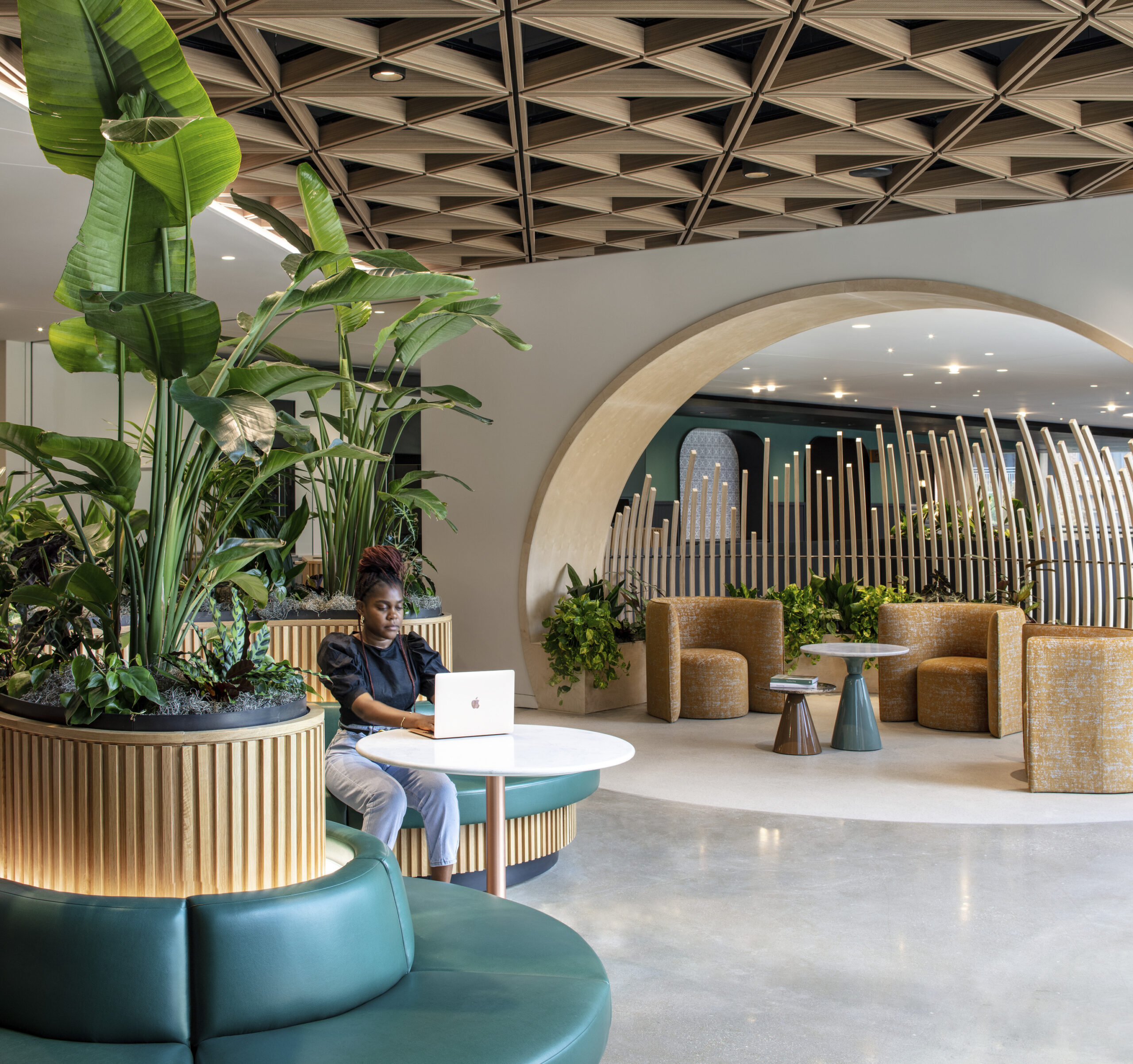 Amazon’s HQ2 campus includes two 22-story towers with green roofs, outdoor meeting areas and operable windows for fresh air. A charcoal terracotta podium nods to the site’s history as a brickyard, while passive thermal lobbies and public art create an engaging environment.
Amazon’s HQ2 campus includes two 22-story towers with green roofs, outdoor meeting areas and operable windows for fresh air. A charcoal terracotta podium nods to the site’s history as a brickyard, while passive thermal lobbies and public art create an engaging environment.
 Google’s first mass timber office building sets a high bar for sustainable and adaptable workplace design. The five-story structure prioritizes health and carbon reduction, using exposed cross-laminated timber (CLT) and glulam beams to create a warm, natural environment. A four-story atrium with a timber-glass skylight floods the interior with natural light and connects open spaces across levels.
Google’s first mass timber office building sets a high bar for sustainable and adaptable workplace design. The five-story structure prioritizes health and carbon reduction, using exposed cross-laminated timber (CLT) and glulam beams to create a warm, natural environment. A four-story atrium with a timber-glass skylight floods the interior with natural light and connects open spaces across levels.
 TikTok’s New York City headquarters occupy the top five floors of the H&M Tower at 42nd and Broadway, encompassing 150,000 square feet designed to reflect the city’s vibrant energy.
TikTok’s New York City headquarters occupy the top five floors of the H&M Tower at 42nd and Broadway, encompassing 150,000 square feet designed to reflect the city’s vibrant energy.
 Pinterest’s new six-story headquarters in San Francisco’s SOMA district creates a connected urban campus with their earlier workspaces nearby. The design reflects Pinterest’s ethos: clean, simple and intuitive with the aim of fuelling creativity. The ground-level lobby doubles as a Privately Owned Public Outdoor Space (POPOS), with glass walls and an operable corner opening to a landscaped alley. Inside, a custom wood ceiling and built-in furniture create a warm threshold between the company and the city.
Pinterest’s new six-story headquarters in San Francisco’s SOMA district creates a connected urban campus with their earlier workspaces nearby. The design reflects Pinterest’s ethos: clean, simple and intuitive with the aim of fuelling creativity. The ground-level lobby doubles as a Privately Owned Public Outdoor Space (POPOS), with glass walls and an operable corner opening to a landscaped alley. Inside, a custom wood ceiling and built-in furniture create a warm threshold between the company and the city.
 NVIDIA’s Voyager building in Santa Clara, California, is a 750,000-square-foot workspace designed to connect employees with nature. Its undulating roof, featuring numerous triangular skylights, floods the interior with natural light, creating an open and airy environment.
NVIDIA’s Voyager building in Santa Clara, California, is a 750,000-square-foot workspace designed to connect employees with nature. Its undulating roof, featuring numerous triangular skylights, floods the interior with natural light, creating an open and airy environment.

































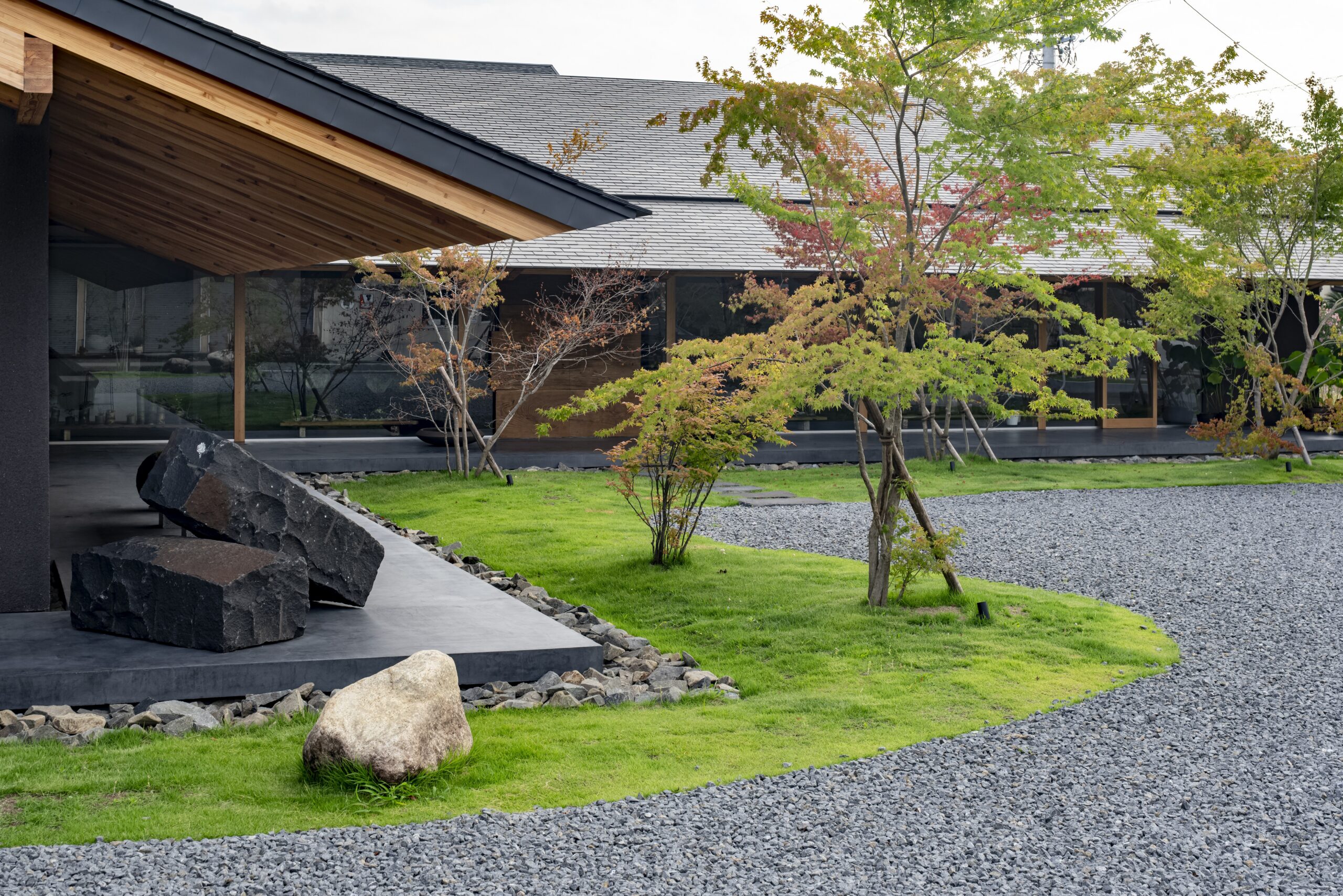
 Florist, plant shop, cafe. More than just a retail complex in a touristic area, Komonokaen responds to the client’s desire to “create a new landmark space” for the locality with a timber roof that juts out beyond the walls. Covered in 20,000 pieces of stone sourced from nearby, the use of local artisan labour, materials and design accentuates the strong regional identity that plays a big part in driving visitor numbers.
Florist, plant shop, cafe. More than just a retail complex in a touristic area, Komonokaen responds to the client’s desire to “create a new landmark space” for the locality with a timber roof that juts out beyond the walls. Covered in 20,000 pieces of stone sourced from nearby, the use of local artisan labour, materials and design accentuates the strong regional identity that plays a big part in driving visitor numbers.
 Modern minimalism revitalizes the traditional rural community through a hang-out for friends, family and the residents of an old countryside estate. Boasting covered porch for chitchatting with passing neighbors, and a number of open spaces born to host, it’s a pro-active, sociable response to the decline and isolation places like this outlying settlement near Nagaoka, where Hara House is located, are experiencing gassh?-zukuri in the age of urbanization.
Modern minimalism revitalizes the traditional rural community through a hang-out for friends, family and the residents of an old countryside estate. Boasting covered porch for chitchatting with passing neighbors, and a number of open spaces born to host, it’s a pro-active, sociable response to the decline and isolation places like this outlying settlement near Nagaoka, where Hara House is located, are experiencing gassh?-zukuri in the age of urbanization.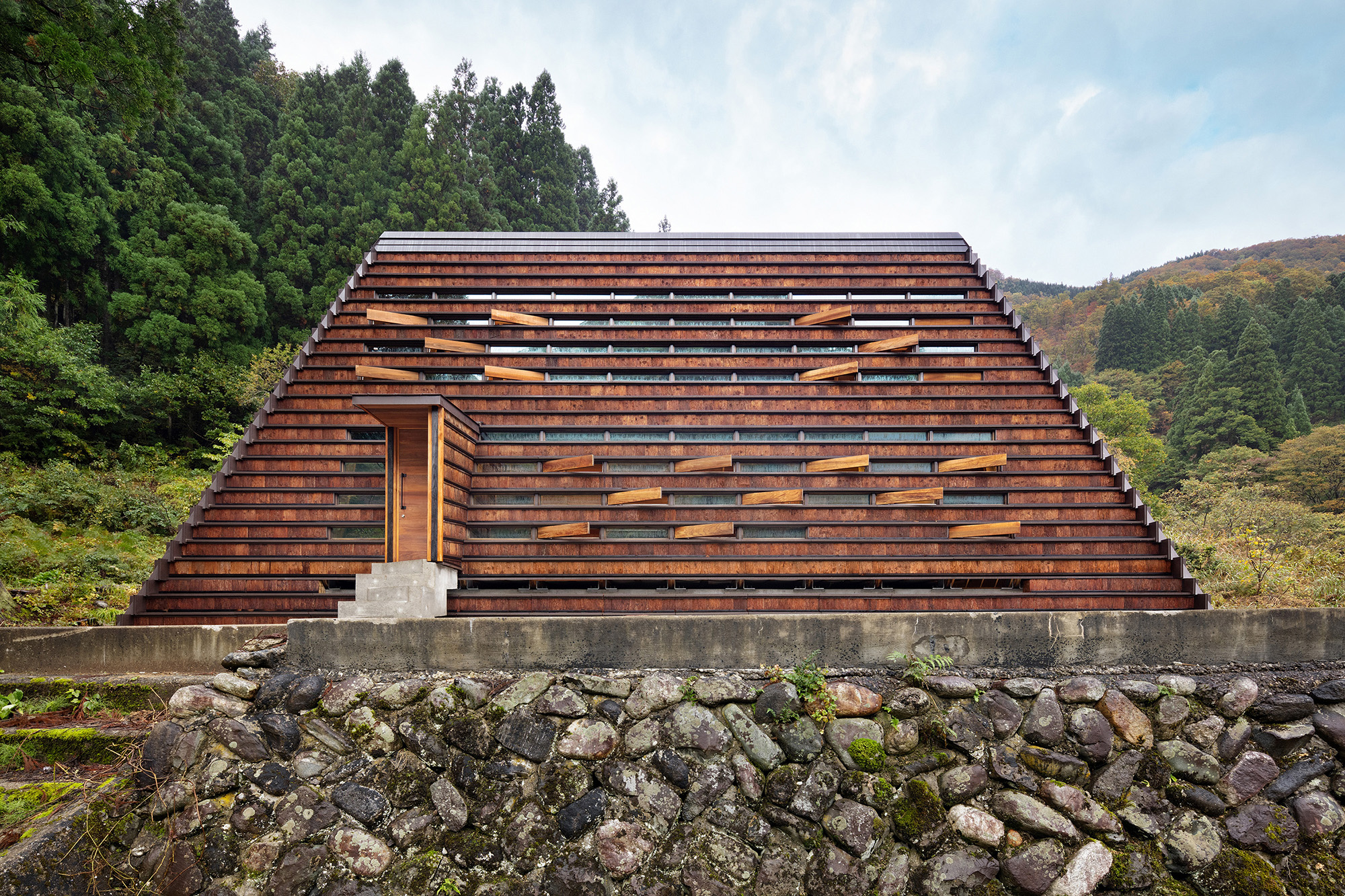
 Another project inspired by rural population loss, and then the Covid-19 triggered rush for remote working from remote locations, House for Marebito updates the gassh?-zukuri principle to raise a bridge between traditional home and temporary accommodation, with each address crowdfunded and shared between investors.
Another project inspired by rural population loss, and then the Covid-19 triggered rush for remote working from remote locations, House for Marebito updates the gassh?-zukuri principle to raise a bridge between traditional home and temporary accommodation, with each address crowdfunded and shared between investors.

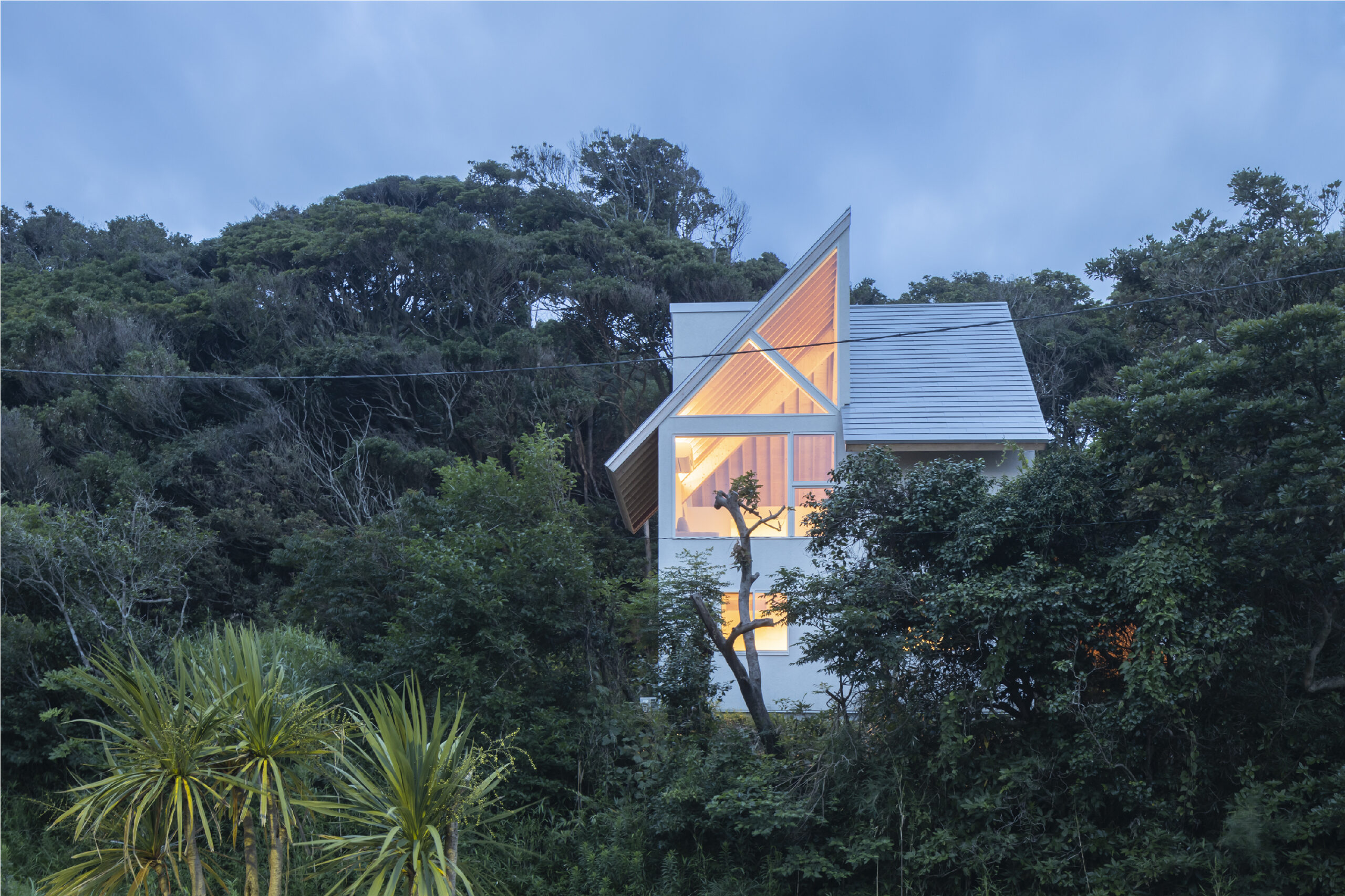 Earlier iterations focused on winding walls and expansive openings; however, soon this approach was seen as a fixation on boundaries. Since the aim was to develop new relationships with the building’s surroundings, a dynamic roof — divided into four sections, each lengthened towards the ground — became a jumping-off point. Generous spaces are formed beneath the extended eaves.
Earlier iterations focused on winding walls and expansive openings; however, soon this approach was seen as a fixation on boundaries. Since the aim was to develop new relationships with the building’s surroundings, a dynamic roof — divided into four sections, each lengthened towards the ground — became a jumping-off point. Generous spaces are formed beneath the extended eaves.

 Axel Vansteenkiste says the design for Ushimaru Restaurant is “European-style.” The Ghent, Belgium trained architect clearly has plenty of Flemish overhangs to call on for inspiration, although here things are more in keeping with traditional local designs. That 45-degree pitched roof is a bold feature, which beautifully encloses the new interior lounge area with striking overall effect.
Axel Vansteenkiste says the design for Ushimaru Restaurant is “European-style.” The Ghent, Belgium trained architect clearly has plenty of Flemish overhangs to call on for inspiration, although here things are more in keeping with traditional local designs. That 45-degree pitched roof is a bold feature, which beautifully encloses the new interior lounge area with striking overall effect.

 The Toyohashi Orthodontic Office is about using gassh?-zukuri to break with tradition, rather than celebrate it. In Aichi, typical buildings have become “standardized”, so here the emphasis is on disrupting uniformity through a series of triangular roof sections extending beyond the structure and transparent lower facade. The result is a series of differently-angled viewpoints of the surrounding city.
The Toyohashi Orthodontic Office is about using gassh?-zukuri to break with tradition, rather than celebrate it. In Aichi, typical buildings have become “standardized”, so here the emphasis is on disrupting uniformity through a series of triangular roof sections extending beyond the structure and transparent lower facade. The result is a series of differently-angled viewpoints of the surrounding city.
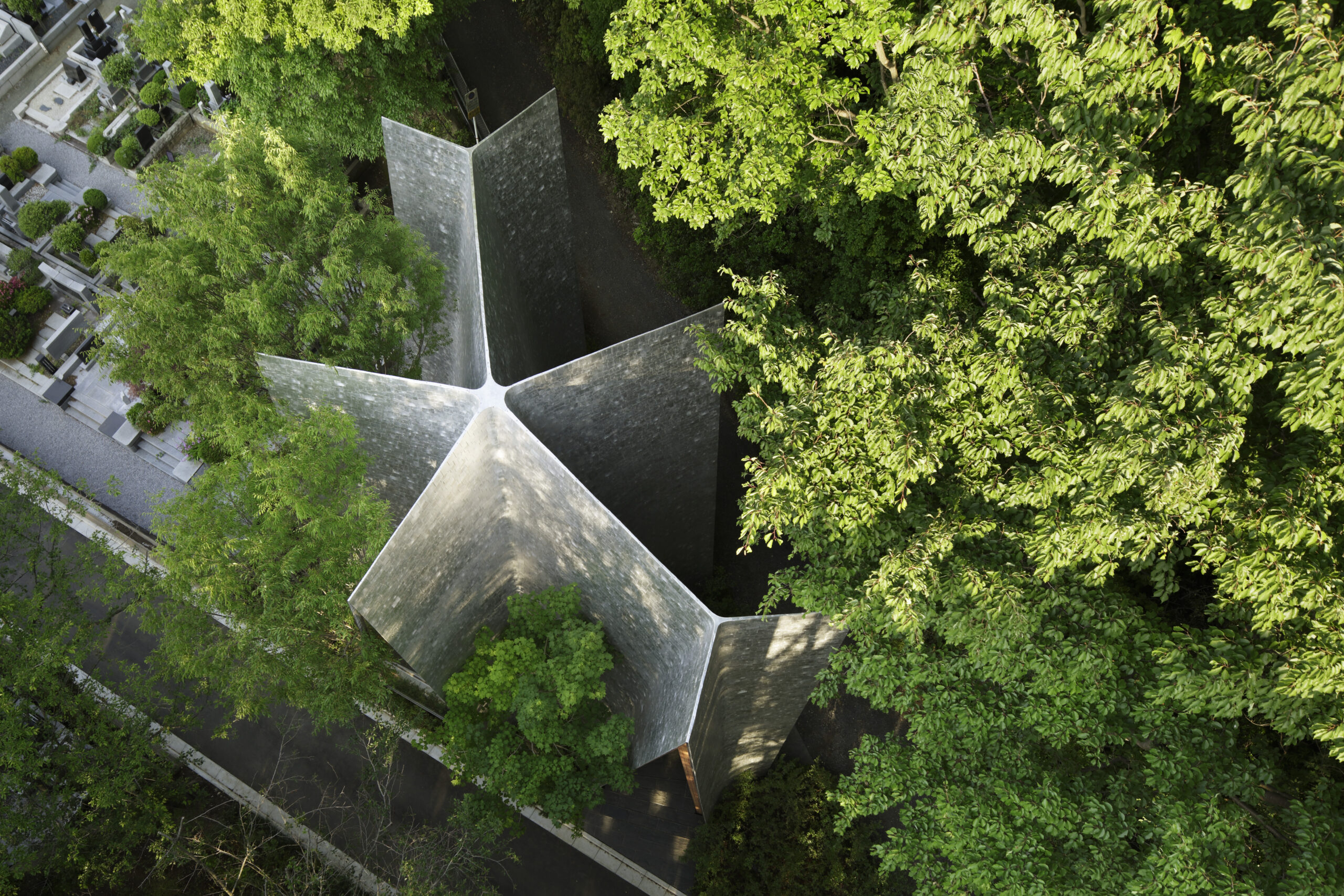
 A space for reflection at the Sayama Lakeside Cemetery, Sayama Forest Chapel is protected from the threat of heavy downpours, but it also looks to safeguard the environment with those inward sloping walls chosen in a bid to avoid uprooting existing trees. Externally, the ground-to-vanishing point roofs performs another role, too, pulling eyes high into the forest canopy and out “towards the departed,” focusing minds on those we want to remember within this stunning setting
A space for reflection at the Sayama Lakeside Cemetery, Sayama Forest Chapel is protected from the threat of heavy downpours, but it also looks to safeguard the environment with those inward sloping walls chosen in a bid to avoid uprooting existing trees. Externally, the ground-to-vanishing point roofs performs another role, too, pulling eyes high into the forest canopy and out “towards the departed,” focusing minds on those we want to remember within this stunning setting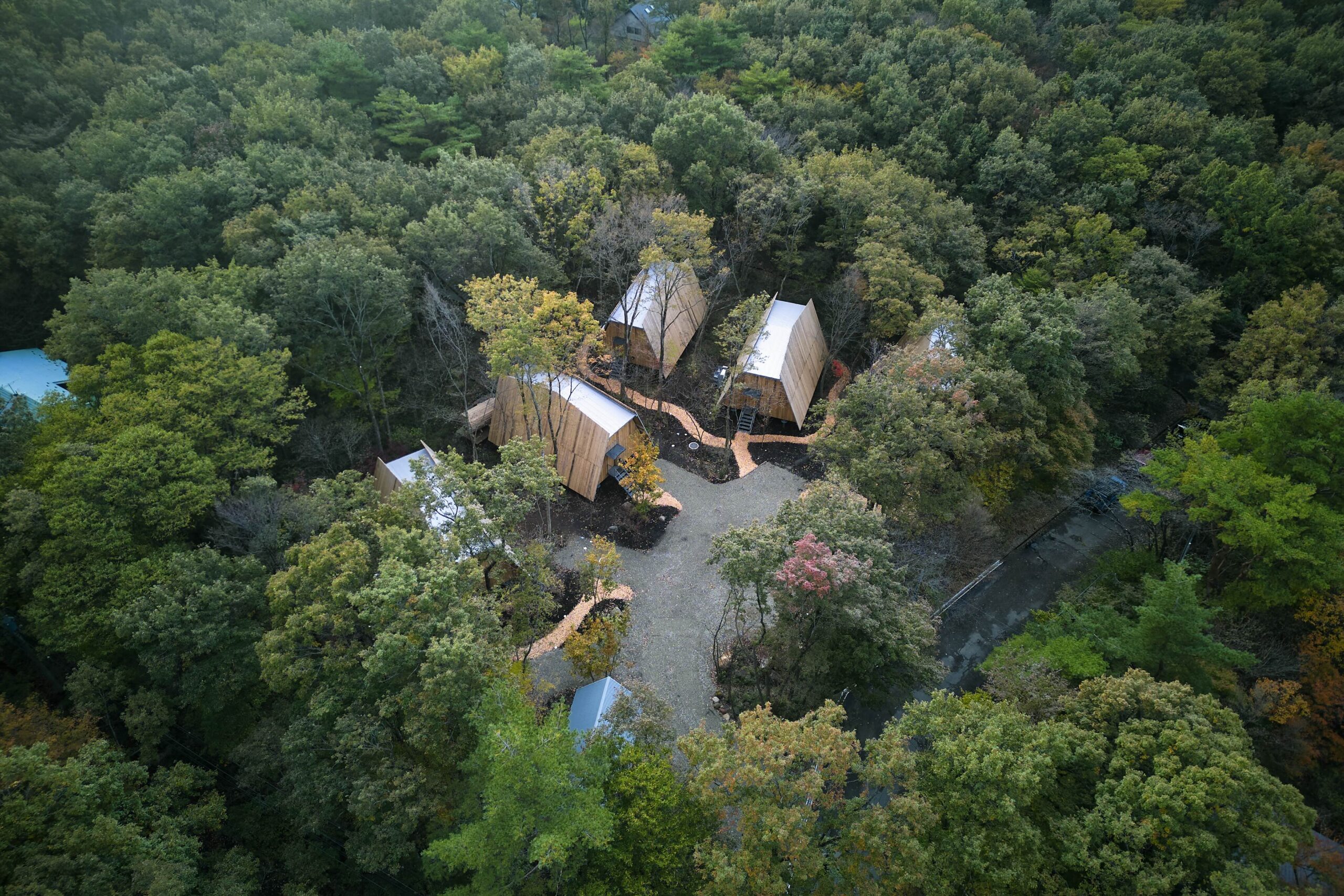
 “Live within nature” is the tagline of SANU 2nd Home, a Japanese remote working property firm that offers professionals the opportunity to escape into the woods for a quietly motivating change of pace. The gassh?-zukuri-style roof forms part of a wider building system mimicking a beehive, too, its honeycomb nature adding strength and stability to a relatively basic cabin structure.
“Live within nature” is the tagline of SANU 2nd Home, a Japanese remote working property firm that offers professionals the opportunity to escape into the woods for a quietly motivating change of pace. The gassh?-zukuri-style roof forms part of a wider building system mimicking a beehive, too, its honeycomb nature adding strength and stability to a relatively basic cabin structure.

 Tosayamadacho Nakagonyu has been home to a kanamine shinto community for more than 200 years. Like so many hamlets across the globe, the number of residents has been in decline for years, and in 2015 the one remaining house and nearby shrine suffered typhoon damage. Ten students from nearby Kochi University of Technology and the villagers rebuilt the sacred site using gassh?-zukuri principles.
Tosayamadacho Nakagonyu has been home to a kanamine shinto community for more than 200 years. Like so many hamlets across the globe, the number of residents has been in decline for years, and in 2015 the one remaining house and nearby shrine suffered typhoon damage. Ten students from nearby Kochi University of Technology and the villagers rebuilt the sacred site using gassh?-zukuri principles.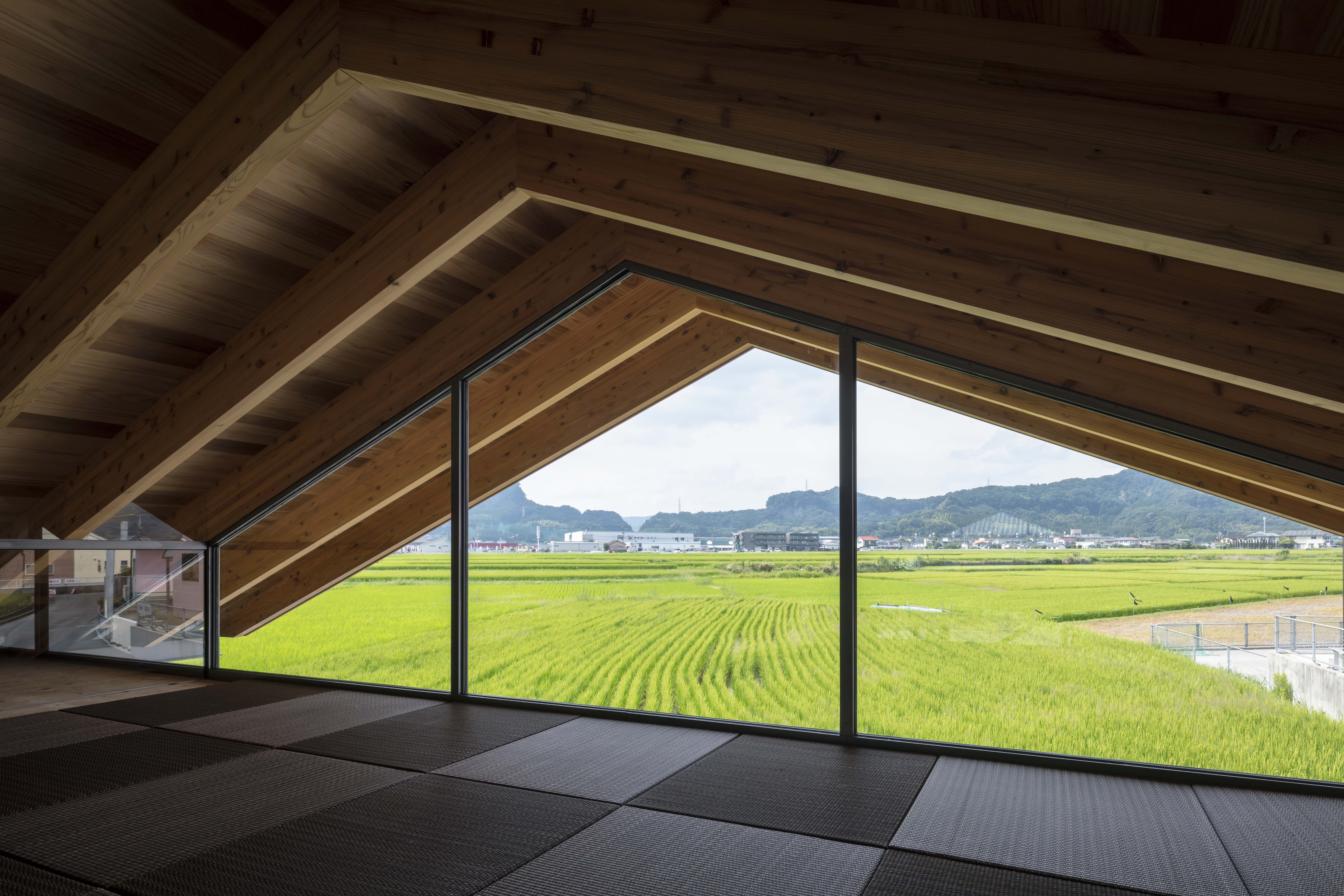

 Taking open plan to another level, the Air House celebrates transparency in the literal sense. Huge spaces are dedicated to the non-living areas, while tiny home principles are introduced to bring living quarters into cozier proximity, with floor-to-extended roof glass wall providing a transition into the neighbouring field, creating the kind of high-impact view residential architects would be hard pushed to better.
Taking open plan to another level, the Air House celebrates transparency in the literal sense. Huge spaces are dedicated to the non-living areas, while tiny home principles are introduced to bring living quarters into cozier proximity, with floor-to-extended roof glass wall providing a transition into the neighbouring field, creating the kind of high-impact view residential architects would be hard pushed to better.
 This angular glass pyramid commands attention in Pardis Technology Park, rising naturally from the landscape. The glass façade invites natural light, while aluminum profiles manage heat efficiently.
This angular glass pyramid commands attention in Pardis Technology Park, rising naturally from the landscape. The glass façade invites natural light, while aluminum profiles manage heat efficiently.
 Set on a sloped site in Tehran’s Velenjak neighborhood, this building takes advantage of its 15% elevation difference to create green patios and urban plazas at street level. These terraces connect directly to the commercial zone while providing much-needed public spaces for the neighborhood.
Set on a sloped site in Tehran’s Velenjak neighborhood, this building takes advantage of its 15% elevation difference to create green patios and urban plazas at street level. These terraces connect directly to the commercial zone while providing much-needed public spaces for the neighborhood.
 Located on the surreal, colorful landscapes of Hormuz Island, Majara Residence is part of a broader initiative to empower the local community through sustainable tourism and economic opportunity. This cluster of small domes, built using the Superadobe technique developed by Nader Khalili, draws inspiration from the island’s natural topography and traditional architecture.
Located on the surreal, colorful landscapes of Hormuz Island, Majara Residence is part of a broader initiative to empower the local community through sustainable tourism and economic opportunity. This cluster of small domes, built using the Superadobe technique developed by Nader Khalili, draws inspiration from the island’s natural topography and traditional architecture.


 This project addresses the loss of privacy in contemporary Iranian residential architecture by reinterpreting traditional design principles. The façade is covered in a grid of rotating bricks, creating openings that balance light, ventilation and privacy while reducing noise from the busy neighborhood.
This project addresses the loss of privacy in contemporary Iranian residential architecture by reinterpreting traditional design principles. The façade is covered in a grid of rotating bricks, creating openings that balance light, ventilation and privacy while reducing noise from the busy neighborhood.
 This project reimagines the traditional Iranian courtyard house through curved volumes and a central courtyard that connects the interior with the outdoors. Openings in the walls, a pool at the base and arched forms allow light and air to flow while maintaining privacy.
This project reimagines the traditional Iranian courtyard house through curved volumes and a central courtyard that connects the interior with the outdoors. Openings in the walls, a pool at the base and arched forms allow light and air to flow while maintaining privacy.
 Located in a historic pomegranate garden in Kerman, this residence retains the original thatched wall, adding a glass entryway to connect the garden’s sycamore trees and watercourse with the community. This approach reflects the Iranian tradition of shared garden spaces.
Located in a historic pomegranate garden in Kerman, this residence retains the original thatched wall, adding a glass entryway to connect the garden’s sycamore trees and watercourse with the community. This approach reflects the Iranian tradition of shared garden spaces. Woof Shadow reinterprets traditional Iranian ideas of light, shade and privacy through a modern brick façade. Inspired by origami, the folded surface creates depth and texture, using bricks—a material central to Iran’s architectural heritage.
Woof Shadow reinterprets traditional Iranian ideas of light, shade and privacy through a modern brick façade. Inspired by origami, the folded surface creates depth and texture, using bricks—a material central to Iran’s architectural heritage.










